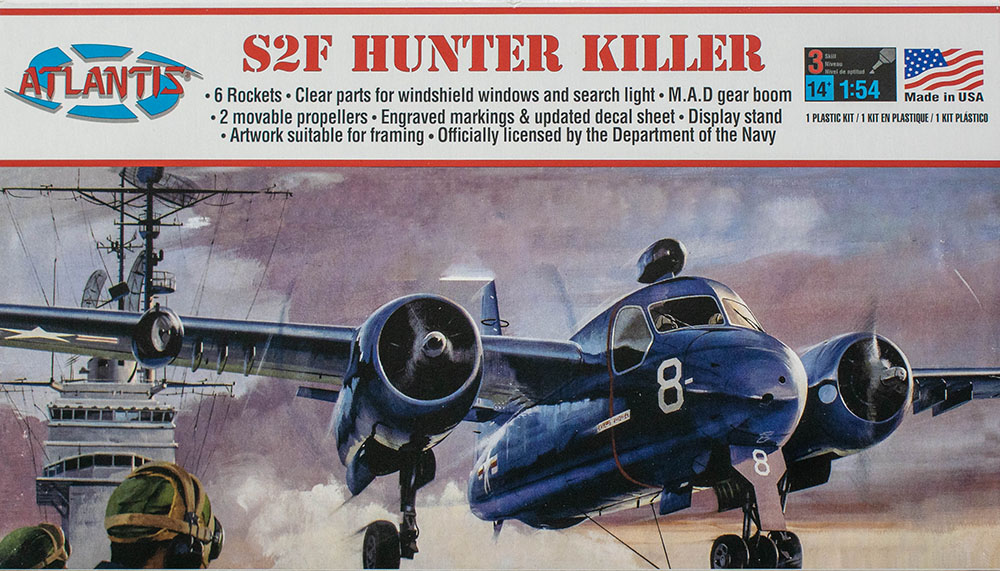
Atlantis Model Company 1/54 S2F Hunter Killer Kit First Look
By Michael Benolkin
| Date of Review | January 2020 | Manufacturer | Atlantis Model Company |
|---|---|---|---|
| Subject | S2F Hunter Killer | Scale | 1/54 |
| Kit Number | A145 | Primary Media | Styrene |
| Pros | Welcome return of a classic subject | Cons | See text |
| Skill Level | Basic | MSRP (USD) | $19.95 |
First Look
 |
 |
Grumman's S-2 Tracker was the first purpose-built carrier-based anti-submarine warfare (ASW) aircraft in the world. Previous carrier-based ASW aircraft included the TBF Avenger (converted torpedo aircraft) and the AF Guardian which took two aircraft to perform the ASW mission - one with the sensors (hunter) and the other with the weapons (killer). Both of these types were also Grumman designs and based upon operational experience, the S-2 was built around the latest suite of ASW sensors including radar, sonobouys, and a retractable magnetic anomaly detector (MAD) boom. Powered by a pair of 1500 horsepower Wright Cyclone engines, this aircraft could loft 4800 pounds of weapons in its weapons bay and under the six hardpoints under the wings and operate quite effectively from the Essex-class aircraft carriers in service at that time.
Under the original USN aircraft designation system, this aircraft was designated S2F (routinely pronounced STOOF (S-two-F)) until 1962, when all US military aircraft were placed under a common designation system and S2F became S-2. Prior to 1962, different variants were designated by a dash number such as S2F-1 which later became S-2A. The S-2D (formerly S2F-3), S-2E (formerly S2F-3S), and S-2G were all based upon an enlarged airframe. The S-2 airframe was not only a very effective ASW platform for the US Navy, it was also adopted by the air arms of Argentina, Australia, Brazil, Canada, Japan, the Netherlands, Peru, Taiwan, Turkey, and Uruguay. In addition to ASW, the S-2 airframe was modified to serve other special missions such as the E-1 Tracer (early AWACS), C-1 Trader carrier onboard delivery (COD), RS-2 photo reconnaissance, and WF-2 weather observer. Even after a long and distinguished military career, the S-2 was also highly sought after as a fire bomber and fought fires in the US, Canada, France, and the Netherlands.
Aurora produced a kit of the S2F Tracker in 1/54 scale back in the 1960s but the tooling originated with a company called Comet and they first released this kit in the mid-1950s. Aurora's toolings ended up in Revell-Monogram's hands until Hobbico (owners of Revell-Monogram and Revell/Germany) went bankrupt a few years ago, and the molds that remained in storage in the U.S were acquired by Atlantis Models. They have been reissuing kits that haven't been available in years, if not decades, and in the case of this kit, it was never reissued by Revell-Monogram, so it has been a scary number of decades since it last saw the light of day. Before you ask "why 1/54 scale?", remember that kits produced in the 1950/60s were produced in box scale. The concept of standardized model scales like 1/72 had not happened yet, and kits were made to fit within the constraints of standard retail box sizes. Standard box sizes made it easier for retailers to stock and display these kits on their limited shelf spaces.
As with many of these early plastic kits, there is no interior detail, but the kit does feature clear windows for the cockpit, so best to paint the inside black. The only real option in the kit is the ventral search radar's radome can be displayed retracted or extended. Otherwise, this is a very straightforward build. Given the age of the molds (!!!), there are some flash and mold artifacts around the edges, but this won't be difficult to clean up, especially with a Sujuburido file. The kit was designed to be displayed in-flight, so flaps are up, flight control surfaces are neutral, and a generic display stand is included.
The decals include markings for what's supposed to be an S2F-1 with buno 138308 assigned to VS-39, but that bureau number belongs to an F7U Cutlass. I think the original decal designer meant to use 136308 which is an S2F-1, and it will be easy to modify the decals to correct this. Decals for the early overall dark sea blue scheme or the later gull gray over white are provided. Decal placement on this kit is really easy as the tooling is so old, they scribed the locations of the decals into the kit's surfaces.
It is nice to see these kits back on the market. Not only are they priced right and simple enough for beginning modelers, but they are great for experienced modelers who want an easy project to clear their creative cobwebs.







